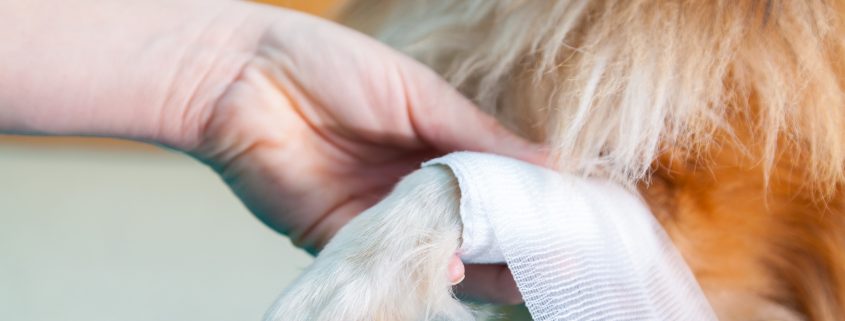You call them your fur babies because they’re a part of your family. No matter where you and your pet are, you should be prepared to care for them just as you would any other human family member. Whether you’re at an outdoor cafe or playing in the park, accidents happen and sometimes they can be nerve wracking. Having the ability to provide first-aid on the way to a veterinary clinic can help to lessen the impact of your furry friend’s injury, and offer you some relief as well.
In this day and age, pets have access to better medical care than ever before—from veterinary specialists to emergency vets that are accessible around the clock. Even with these resources available, it’s scary to think about your pet being injured. But in the event of an accident, having a pet first-aid kit gives you easy access to everything you need to address your pet’s injury in a time of crisis.
Most of the supplies you’ll need for your pet first-aid kit are available at your local pharmacy. Explore our guide below that covers everything you should include. Then, even if the worst happens, you’re ready to patch up your furry friend. Ready to start putting together a pet first-aid kit?
First-Aid Basics
Below is a comprehensive list of basic supplies you want to have available in your pet first-aid kit. Pack them into a portable, waterproof bag and keep them in your home, in your car, or on your person when out and about.
- Health Record – Make sure you keep your pet’s most recent immunization records on hand. If your pet needs emergency veterinary attention, you will need to prove your pet is up to date on all vaccinations. If you keep it with the rest of your first-aid supplies, it will be easily accessible.
- Emergency Contacts – Here is a list of emergency numbers you should keep in your first-aid kit. When things go wrong you can become stressed and frazzled, resulting in important information being forgotten. With this list already prepped and ready to go you’ll never have to worry about remembering a phone number off the top of your head.
- Your personal veterinarian
- The closest 24-hour emergency vet clinic
- Pet Poison Helpline (855-764-7661)
- The Animal Humane Society’s 24/7 pet helpline (952-435-7738)
- Tweezers – Tweezers can be helpful for removing small foreign objects from your dog’s skin, coat and paws. They are also useful for removing ticks.
- Thermometer – Normal body temperature for a dogs and cats is much warmer than for humans and ranges from 101° to 102.5° fahrenheit. Consult your veterinarian on how to safely use a thermometer at home without injuring your pet, and have one on hand for those times when you suspect your friend is feeling poorly. If your pet has a fever you should seek veterinary care right away. Do not attempt to treat with over-the-counter human medications as they can be toxic to pets.
- Scissors – You’ll need these to cut through gauze, tape, and bandages. Or, if you run out of those items, you can fashion a makeshift one by cutting whatever fabric is nearby.
- Sterile gloves – To reduce the likelihood of introducing additional bacteria into a wound, it’s a good idea to have and wear sterile gloves when administering first-aid to your pet.
- A Cloth Muzzle – A muzzle is a must-have for your kit—even if your pet is normally well-behaved. Animals that are injured and frightened may act unpredictably and you don’t want to be injured while trying to help them. A muzzle may seem like the last thing you’d ever need, but you may be surprised at your pet’s response to pain or being handled by unfamiliar people in an emergency.
- Bandaging Materials – Include each of the following in your kit: sterile non-stick gauze pads (both 2″ and 4″), gauze rolls, self-adhesive vet wrap, and medical tape. With these supplies, you’ll be able to dress any type of wound. Whether it’s a small scrape from a tumble or a bite wound from another animal, you’ll be able to cover it appropriately with these materials.
- Wound Cleaning Supplies – This can include wound care spray (specifically for pets), or iodine prep pads. Wound sprays are designed for minor injuries such as small cuts, sores, and abrasions. They are safe for your dog if licked or ingested and help provide pain and itch relief. If you opt for iodine prep pads, be sure to dress the wound afterwards to prevent your pet from ingesting the substance.
- Antibiotic Ointment – You can find an antibiotic ointment specifically for your furry friend at your local pet store, but over-the-counter antibiotic ointment available at your local pharmacy is generally considered safe to use on pets in small amounts. These ointments help prevent infection, relieve pain, and provide a barrier against bacteria and germs.When using this, it’s best to securely cover the wound to prevent them from licking the ointment off.
- Flashlight – If you’re out and about after dark and your pet gets hurt, you’ll want to have a light source for inspecting injuries. Pack a flashlight with fresh batteries into your kit so you’ll never be left in the dark.
Extra Supplies
This next list includes optional supplies to place in your pet first-aid kit. The necessity for these really depends on yours and your pet’s lifestyle.
- Splinting Supplies – If you and your pet do a lot of outdoor activities, it’s a great idea to add a flexible splint to your first-aid kit. These splints are great to have on hand when you need to stabilize a pet with a more serious injury.
- Instant Ice Pack – Ice packs are helpful to have in your first-aid kit to alleviate swelling or to bring down body temperature. Just make sure to never place ice directly on your pet’s skin; always wrap ice packs in a towel or small cloth first.
- Styptic powder – Styptic powder contains benzocaine to block pain while it effectively controls minor bleeding caused by cuts, scrapes, or broken toenails.
- Oral syringes – These can be used for a multitude of purposes, including flushing wounds, rinsing debris out of eyes, and giving oral medications.
- Hydrogen Peroxide – If you believe your dog has swallowed something they weren’t supposed to, a 1:1 solution of 3% hydrogen peroxide and water will do the trick to induce vomiting. Peroxide can also be used to clean superficial wounds like cuts and scrapes.
- Charcoal Capsules – Charcoal is another helpful tool that can be used to absorb and counteract substances your pet may have ingested. Be sure to consult with a veterinarian first to determine what size dose is safe for your pet.
- Benadryl – Benadryl is a great medication for use in pets with mild-to-moderate allergies. Seasonal allergies, food allergies, environmental allergies, and allergic reactions to bites from snakes and insects can respond well to Benadryl in most cases. Be sure to consult with a veterinarian first to determine what size dose is safe for your pet.
- Magnifying Glass – A lightweight magnifying glass with LED-illuminated glass can magnify cuts, wounds, splinters, and more. This is definitely helpful when trying to remove small items from your pet’s coat or wound.
- Towel – A super-absorbent, machine-washable microfiber towel can be useful in many ways. It can be used to apply pressure to stop bleeding, to dry your pet off, to keep them warm, or to keep them protected from inclement weather.
- Extra Leash and Collar – In an accident or other emergency, your dog’s collar may come off or the leash may snap. Make sure you have an extra of each so you don’t run the risk of your pet running off.
Your Pets are our Priority!
At the National Animal Supplement Council (NASC), our number one priority is to promote the health and wellbeing of your pets. That is why we created the NASC Audit Program and the Quality Seal, which helps you identify animal health and nutritional supplements that come from responsible suppliers committed to producing the highest quality, most consistent products available. Visit our website to learn more and to see a list of NASC members that have earned the Quality Seal.


